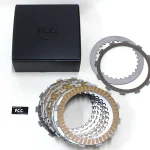The Eliminator, which gained popularity due to its unique "dragger" concept, is one of Kawasaki's most representative names. The Eliminator 250V, the only model in the Eliminator series equipped with a V-type engine, was launched in 1998 during the American motorcycle boom.
Amid the American boom, many companies add V-twin 250s to their lineups
In the 1990s, following the naked motorcycle boom, came the boom of the American (cruiser) motorcycle. Harley Davidson was synonymous with American motorcycles, but many young people could not afford them due to licensing issues and high prices, so they began to customize domestic cruiser models. One of the catalysts for this American customization boom was the custom Harley Davidson FXRS ridden by Mickey Rourke in the movie "Harley Davidson & Marlboro Man" released in 1991. At the time, custom motorcycle shops were all over the place making replicas of this based on Steeds and other models, and in fact, many of these "Marlboro Man" customizations could be seen on the streets.
Honda's Steed, released in 1988, saw a rapid increase in sales as it was found to be a good base for customization. New mid-sized models equipped with V-twin engines, such as Suzuki's Intruder and Yamaha's Drag Star, were introduced. Kawasaki had been developing the Eliminator series since the 1980s, which was designed more as a drag racer than a cruiser, but in 1995, they introduced the Vulcan 400, a full-fledged cruiser model equipped with a V-twin engine, to the Japanese market.
Furthermore, following the 400cc models, each company began to introduce new models in the 250cc class. Incidentally, before this boom, the only 250cc class cruiser equipped with a V-twin engine was Yamaha's Virago 250. Each company had a lineup of models equipped with a V-twin engine: Honda had the V-twin Magna, Yamaha the Drag Star 250, and Suzuki the Intruder LC250. Naturally, Kawasaki was expected to introduce the Vulcan 250, but what was introduced into this category was the Eliminator 250V, equipped with a newly designed water-cooled V-twin engine.

The Yamaha Virago 250, equipped with an air-cooled, four-stroke, V-twin, 248cc engine, was released in 1988. It was the pioneer of 250cc class V-twin engine cruisers.

The Honda V-Twin Magna, which appeared in 1994, was equipped with a VT250-series engine and adopted a high-tech custom design. It gained popularity with a volume that was hard to believe for a 250cc class motorcycle, and it became the main player in the boom.

Yamaha's Drag Star 250 was released in 2000. It was longer and lower than the Virago. By the way, it was not a model change of the Virago, but the Virago was sold alongside it.

The Suzuki Intruder 250LC was released in 1999. Despite its simple design, it had practical functionality with luggage space under the seat.

The Eliminator 250V, released in 1998, was a unique model that added cruiser elements to the Eliminator series' dragger concept.

The Eliminator 250V has a voluminous rear section, highlighting its long and low design from the rear.
The Eliminator series follows a unique "Dragger" approach
Kawasaki's Eliminator series began in 1985 with the 900, which had a GPZ900R engine converted to shaft drive and mounted on a low and long drag racer-style vehicle, and the 750, which had a lower displacement for the domestic market. In 1986, the 400 was released, equipped with a GPZ400R-series engine also converted to shaft drive, and created a unique genre of drag racer replicas called "Dragers". In 1988, the 250, equipped with a GPZ250-series in-line twin-cylinder engine, was added to the lineup, and the 250 adopted a chain drive and was equipped with an engine with a maximum output of 40 PS, making it worthy of the "Drager" name.
The Eliminator 250 had succeeded in gaining a certain number of fans by adding the SE, which had blacked-out parts and a bikini cowl, and the LX, which had spoke wheels. Although the Eliminator 250 was competing well among the V-twin models, it was undeniable that it felt outdated after 10 years since its release. Then, in 1998, Kawasaki released the long-awaited fully redesigned Eliminator 250 to the market.

The Eliminator 250 was released in 1988. With a design that was distinct from cruisers, it became a hit model along with its siblings.

The Eliminator 250's engine base is the GPZ250R's DOHC 4-valve in-line 2-cylinder engine. The GPX250 is equipped with a high-performance engine with 45 PS.

The Eliminator 250SE is a blacked-out model fitted with a sporty bikini cowl, giving it an even more drag racer feel.

The Eliminator 250LX is a model that features spoke wheels and two-tone coloring, giving it a stronger cruiser feel.
Is the V-engine heresy, innovation, or a trend?
This new model, named the "Eliminator 250V", has a long wheelbase body and is equipped with a specially designed water-cooled V-type DOHC 4-valve engine, from which the "V" comes. While the style inherits the drag image, it has a long and low design with the forks laid back quite a bit. Considering that the previous Eliminator 250 had a total length of 2140mm and a wheelbase of 1490mm, the Eliminator 250V, with a total length of 2355mm and a wheelbase of 1620mm, has a presence that can be said to be one rank higher.
The Eliminator series had a loyal fan base thanks to its unique drag image, but the boom in American motorcycles was an important factor for sales. And as a prerequisite, it must have had to be equipped with a V-type engine. However, the amount of power put into the new Eliminator 250V engine is clear when you consider that the water-cooled V-type DOHC 4-valve engine, 249cc, was specially developed. This engine produced a maximum output of 35PS/12500rpm and 2.4kg-f/9500rpm, making it the most powerful cruiser model in the 250cc class. From the engine specs, it seems that Kawasaki wanted to position this bike as a vehicle that inherited the concept of a "dragger" rather than a "cruiser".
Naturally, we can assume that consideration was given to using the original in-line twin-cylinder engine or an in-line four-cylinder engine, but among the 250cc cruisers released earlier by various manufacturers, Honda's V-twin Magna was extremely popular, and considering that this Magna was released in 1994, it is highly likely that it influenced the direction of the Eliminator 250V.

The handling feels much sportier than you'd imagine from the long, slack front forks. The engine has such power that you'd want to rev it up rather than ride it slowly.

The riding position is cruiser-like, with the upper body almost upright and the feet slightly forward.

The rider is 165 cm tall and weighs 55 kg, with both feet firmly on the ground with a little room at the knees.

The engine is a specially designed water-cooled V-type DOHC 4-valve 249cc engine that produces a maximum output of 35PS, making it the most powerful power unit for a 250cc cruiser model.

The headlights are bottom-mounted, and you can see that the triple tree is angled quite a bit.

The handlebars are drag bar type with integrated risers. The risers are set high, making your upper body feel more upright.

The meter only shows the speed, and is a tank-mounted type. The indicators are placed between the meter and the tank cap, and the tank capacity is 13L.

The seat has a cruiser-like design, is wide and comfortable to sit on, and the seat itself is large, so it's also comfortable for pillion riding.

The tail area has a cruiser-style design with chromium plated seat rails and sharply designed fenders.

The footpegs are set slightly forward, but you can put your weight firmly on the step without feeling like your foot is completely thrown out.

The exhaust system is a megaphone type, reminiscent of a highly elevated drag racer.

The front wheel attached to the end of the long front fork is 17 inches, and the brakes are disc type.

The rear suspension is a square swingarm + twin shock absorber, and the tires are a thick size of 160/80-15.

The rear brake is a drum type, ensuring sufficient braking power when needed.
What about the next-generation Eliminator 250??
The Eliminator 250V was discontinued in 2007 due to emissions regulations, but for about 10 years it was the only American-style bike in Kawasaki's light motorcycle class. The bike in the photo is the final 2007 model, and this passion red has been added to the color scheme that had been available in ebony (black) for a while.
The Eliminator 250V was not an explosive hit, but its long lifespan can be considered a measure of the quality of the bike itself. With the revival of the Eliminator 400 in 2023, there are rumors that a new Eliminator 250 will be released. Since the 400 is equipped with a parallel engine, it is likely to be released with a parallel engine, but we will have to wait and imagine whether it will be a two-cylinder or four-cylinder, or even a V-type in a big twist.
Eliminator 250V Main Specifications (2007)
Overall Length x Width x Height: 2355 x 775 x 1075 mm
Wheelbase: 1620mm
Seat Height: 690mm
Dry Weight: 171kg
Ezine: liquid-cooled 4-stroke DOHCV 2-cylinder 4-valve 249cc
Maximum Output: 35 PS/12500 rpm
Max. Torque: 2.4㎏m/9500 rpm
Fuel Tank Capacity: 13L
Transmission: 6-speed return
Brakes: F=disc, R=drum
Tire: F=120/80-17, R=160/80-15
Price: $3746.24 (Price at time including tax)



